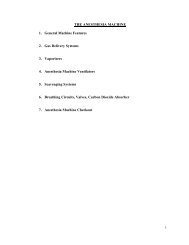BUMC Basics.pdf - Anesthesia Home
BUMC Basics.pdf - Anesthesia Home
BUMC Basics.pdf - Anesthesia Home
You also want an ePaper? Increase the reach of your titles
YUMPU automatically turns print PDFs into web optimized ePapers that Google loves.
39<br />
• Erythromycin<br />
• Phenothiazines<br />
- Short QTc is caused by hyperkalemia,<br />
hypermagnesemia, and hypercalcemia.<br />
Hypertrophy and Enlargement<br />
• P (atrial depolarization)<br />
II (nl: 3mm<br />
more Negative (>1mm)<br />
RAE Tall >2.5mm More Positive Peak<br />
>1.5mm<br />
• Ventricular hypertrophy<br />
- LVH: kissing waves, S in V1 + R in V5/6 >35mm, R<br />
in aVL >11mm, or R in V4-V6 >25mm<br />
- RVH: tall R wave in V1 with an amplitude > 7 mm or<br />
R wave in lead V1 + the amplitude of the S wave in<br />
lead V6 > 10 mm.<br />
Signs of ischemia/infarction<br />
• ST Depression: Indicates ischemia; significant if the ST<br />
segment is depressed by 1 mm or more<br />
• T-Wave Inversion (TWI): Can also indicate ischemia but<br />
can be due to LVH with strain, abdominal pain,<br />
medications (digitalis), and CNS hemorrhage.<br />
• ST elevation (STE): indicates transmural infarction<br />
(injury); significant elevation is 1 mm in the limb leads and<br />
2 mm in the precordial leads.<br />
• Q wave: indicates muscle death from a lack of blood<br />
supply. A Q wave is considered pathologic if it is 1 small<br />
box wide and deeper than 25% of the R wave. “Q’s in III<br />
are free”.<br />
Other<br />
• Early repolarization: Concave “Happy” STE (early repol<br />
which is seen in young pts and those w/ LVH, pericarditis,<br />
myocarditis, head contusion, PTX)<br />
• Low Voltage (




